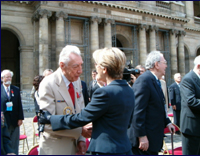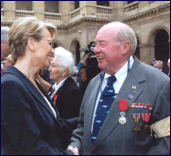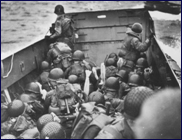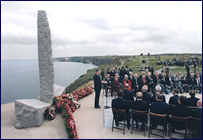Early in the morning on 6 June 1944, the usual crowd of several hundred gathered outside St. Patrick's Cathedral on
Manhattan's Fifth Avenue for the first regular Mass. In New York's Times Square, many Americans first learned from
electronic bulletins that D-Day had begun. General Eisenhower announced, "The tide has turned … We will accept nothing
less than full victory." Although it had not been rung for over 100 years, the fragile Liberty Bell in Philadelphia
began ringing, broadcast throughout the nation over NBC radio. President Roosevelt wrote a D-Day prayer he would
deliver on the radio. By nightfall, 75,000 grateful New Yorkers had worshipped at St. Patrick's Cathedral. The
Statue of Liberty, darkened since the war's early days, was ablaze again - a full 96,000 watts.
 |  |
Soldiers and beach battalion sailors were threatened with court-marshal for taking diaries or cameras ashore on
Normandy D-Day. Photographs were only to be taken by war correspondents and official Army and Navy photographers.
Robert Capa's famous photos taken on the Easy Red sector of Omaha Beach were some of the invasion's first. Four
days later, the Robert Capa photos appeared in LIFE magazine.
LIFE published their 60th anniversary commemorative issue of D-Day, covering June 6 through August 1944 of the
invasion. Robert Capa's Easy Red photos appear just as they were printed more than half a century ago. The
introduction states, "The Americans who fought in World War II have been called the greatest generation. If this is
so, D-Day - with its epic bravery and sacrifice, its brilliant success - might have been the finest minute, the
greatest moment."
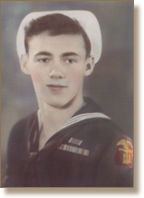 | 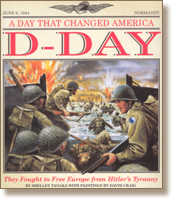 |
| Seaman First Class Bob Giguere, featured in a D-Day book for children, was invited by his
Laconia, NH bookstore to sign copies of D-Day: They Fought to Free Europe from Hitler's Tyranny.
Sixty years ago, after surviving the sinking of the LCI(L) 85, seventeen-year-old Giguere waded ashore Easy Red
and joined the infantry assault, contributing the capture of Omaha Beach. Bob won three purple hearts during
the war and a Silver Star on D-Day. |
On the back of LIFE, The History Channel reminds young Americans, "They were asked to save the world by running into
the jaws of hell." Amphibious sailors interviewed
by The History Channel for a series of D-Day specials include "Easy Red" Beachmaster Joe Vaghi, Coast Guardsmen Ralph Gault, LCI(L) 88,
Elmer Carmichael, LCI(L) 85, bulldozer operator Clyde Whirty, Radioman Red Onines and Corpsman Vince Kordack. S1c Bob Watson, RM3c Torre Tobiassen, RM1c
John Gallagher and HA2c Richard Borden traveled to France for the 60th anniversary of D-Day.
While Radioman John Gallagher (upper left) was sending critical shore-to-ship messages for Commander Carusi from the
Fox Green sector of Omaha Beach, a vicious German artillery attack commenced. Dr. Davey reported, on D+1, Gallagher
"had a 3-cm piece of shrapnel enter his face just below the eye, which passed thru the upper part of the maxillary
sinus, entered the orbit to sever the optic nerve, and lodged in the petrous part of the temporal bone."
Still filled with shrapnel and wearing a glass eye, Gallagher and shipmate Dr. Richard Borden (upper right) returned
to Normandy, by special invitation of the French government, to receive the prestigious Legion of Honor. Founded by
Napoleon Bonaparte in 1802, it is the highest honor that France can bestow upon those who have achieved remarkable
deeds. John Gallagher died five months after receiving the award.
June 6, 2004 represented, for most veterans, their final ten-year D-Day anniversary. Dan van der Vat's D-Day: The Greatest Invasion - A People's History
highlights 6th Beach Battalion veterans with the Introduction by John S.D.
Eisenhower. IKE's son graduated from West Point on D-Day and confessed, "I have felt a secret discomfort that West
Point's Class of 1944 was savoring its graduation at the same time that boys younger than us were clinging desperately
to the cliffs of Normandy or sinking in the English Channel, and yet finally pulling themselves together to launch
the beginning of the liberation of Europe."
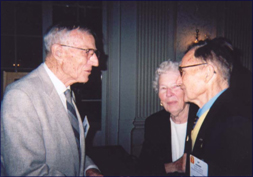 | 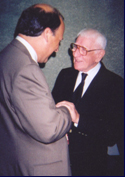 |
| Old D-Day liberators are pictured above. Boatswain's Mate Herb Goodick bids a final farewell
to his C-9 platoon commander, Navy Beachmaster Karl Hein (far left). Herb's wife Ruth proudly observes. S1c
John Hanley bids farewell to Joe Vaghi III, Comdr. Vaghi's son. Love and many memories are shared with the
younger generation in the 6th Beach Battalion Association. John said his affairs were in order and this would
be his last reunion. |
The Veterans Affairs Department estimates World War II vets are dying at a rate of 1,056 a day - more than 385,000 a
year. Fewer than 4 million of the 16 million people who served during the war were alive when the National WWII
Memorial was dedicated in Washington D.C. 29 May 2004. Coxswain Ed Marriott and Albert Rinehimer of platoon C-8
represented the 6th Naval Beach Battalion at the memorial dedication. John Hanley died two days after the dedication,
on Memorial Day. Gene Cook and Bob Moore died in 2004 before the 6th Naval Beach Battalion "last call" reunion in
Peoria, IL. Shipmate Herb Goodick died several months after attending the reunion.
President Bill Clinton signed Public Law 103-32 on 25 May 1993, authorizing the American Battle Monuments Commission
to establish a World War II Memorial in Washington, D.C. It is the first national World War II memorial dedicated to
the achievement of this nation. The memorial honors the 16 million who served in the U.S. armed forces during WWII,
the 400,000 KIA, and the millions of Americans who supported the war effort.
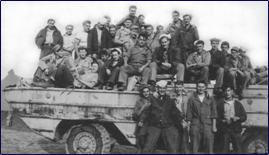 | 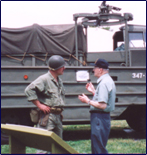 |
| Shortly before the invasion, small boat repair sections were combined into Salvage Group 4
above for the Normandy landings. Living up to their reputation, "Commander Carusi's thieves" had the task of
organizing the beach. They desperately needed an Army amphibious "duck" and subsequently appropriated one from
Point du Hoc. Sixty years later,
Albert Rinehimer explains Salvage Group 4's invasion role to an Army reenactor at the National WWII Memorial Dedication. |
John S.D. Eisenhower, son of the Supreme Allied Commander in World War II, emphasized, "While a memorial to war, this
edifice is more than a tribute to the men and woman of this country whose bloody struggle loosened the world from
tyranny. It marks for all Americans the emergence of the United States as the leader of the Free World in the
mid-twentieth century."
During the memorial dedication, President George W. Bush proclaimed, "On this Memorial Day weekend, the graves will
be visited and decorated with flowers and flags. Men whose step has slowed are thinking of boys they knew when they
were boys together. And women who watched the train leave and the years pass can still see the handsome face of their
young sweetheart. America will not forget them either. At this place, at this memorial, we acknowledge a debt of
long standing to an entire generation of Americans - those who died, those who fought and worked and grieved and went
on. They saved our country, and thereby saved the liberty of mankind."
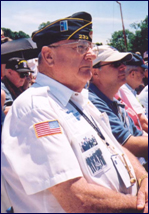 | 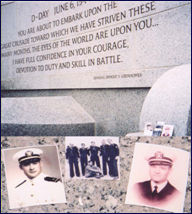 |
| Ed Marriott reflects on his C-8 platoon commander Joe Vaghi, shipmates and Dr. Davey at the
National World War II Memorial Dedication 29 May 2004. Marriott's 6th Beach Battalion C-8 platoon was
attached to the 37th Engineer Combat Battalion, 5th Engineer Special Brigade. The 37th Engineer Combat
Battalion was not forgotten when the late President Ronald Reagan made his famous D-Day address on "Easy Red"
Omaha Beach 6 June 1984. |
June 6, 1984
Omaha Beach, Normandy, France
We stand today at a place of battle, one that 40 years ago saw and felt the worst of war. Men bled and died here for a few
feet of -- or inches of -- sand, as bullets and shellfire cut through their ranks. About them, General Omar Bradley
later said, "Every man who set foot on Omaha Beach that day was a hero."
Some who survived the battle of June 6, 1944, are here today. Others who hoped to return never did.
"Someday, Lis, I'll go back," said Private First Class Peter Robert Zanatta, of the 37th Engineer Combat Battalion,
and first assault wave to hit Omaha Beach. "I'll go back, and I'll see it all again. I'll see the beach, the
barricades, and the graves."
Those words of Private Zanatta come to us from his daughter, Lisa Zanatta Henn, in a heart-rending story about the
event her father spoke of so often. "In his words, the Normandy invasion would change his life forever," she said.
She tells some of his stories of World War II but says of her father, "the story to end all stories was D-Day."
"He made me feel the fear of being on the boat waiting to land. I can smell the ocean and feel the seasickness. I
can see the looks on his fellow soldiers' faces -- the fear, the anguish, the uncertainty of what lay ahead. And
when they landed, I can feel the strength and courage of the men who took those first steps through the tide to what
must have surely looked like instant death."
Private Zanatta's daughter wrote to me, "I don't know how or why I can feel this emptiness, this fear, or this
determination, but I do. Maybe it's the bond I had with my father. All I know is that it brings tears to my eyes to
think about my father as a 20-year-old boy having to face that beach."
The anniversary of D-Day was always special to her family. And like all the families of those who went to war, she
describes how she came to realize her own father's survival was a miracle: "So many men died. I know that my father
watched many of his friends be killed. I know that he must have died inside a little each time. But his explanation
to me was, "You did what you had to do, and you kept on going."
When men like Private Zanatta and all our Allied forces stormed the beaches of Normandy 40 years ago they came not
as conquerors, but as liberators. When these troops swept across the French countryside and into the forests of
Belgium and Luxembourg they came not to take, but to return what had been wrongfully seized. When our forces marched
into Germany they came not to prey on a brave and defeated people, but to nurture the seeds of democracy among those
who yearned to be free again.
We salute them today. But, Mr. President [Francois Mitterand of France], we also salute those who, like yourself,
were already engaging the enemy inside your beloved country -- the French Resistance. Your valiant struggle for
France did so much to cripple the enemy and spur the advance of the armies of liberation. The French Forces of the
Interior will forever personify courage and national spirit. They will be a timeless inspiration to all who are
free and to all who would be free.
Today, in their memory, and for all who fought here, we celebrate the triumph of democracy. We reaffirm the unity of
democratic people who fought a war and then joined with the vanquished in a firm resolve to keep the peace.
From a terrible war we learned that unity made us invincible; now, in peace, that same unity makes us secure. We
sought to bring all freedom-loving nations together in a community dedicated to the defense and preservation of our
sacred values. Our alliance, forged in the crucible of war, tempered and shaped by the realities of the post-war
world, has succeeded. In Europe, the threat has been contained the peace has been kept.
Today, the living here assembled -- officials, veterans, citizens -- are a tribute to what was achieved here 40 years
ago. This land is secure. We are free. These things are worth fighting and dying for.
Lisa Zanatta Henn began her story by quoting her father, who promised that he would return to Normandy. She ended
with a promise to her father, who died 8 years ago of cancer: "I'm going there, Dad, and I'll see the beaches and
the barricades and the monuments. I'll see the graves, and I'll put flowers there just like you wanted to do. I'll
never forget what you went through, Dad, nor will I let any one else forget. And, Dad, I'll always be proud."
Through the words of his loving daughter, who is here with us today, a D-Day veteran has shown us the meaning of this
day far better than any President can. It is enough to say about Private Zanatta and all the men of honor and courage
who fought beside him four decades ago: We will always remember. We will always be proud. We will always be
prepared, so we may always be free.
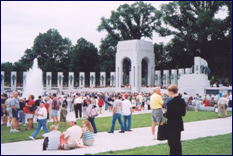 | 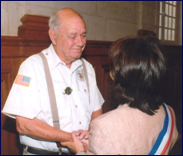 |
| President Ronald Reagan died exactly 60 years to the day after Peter Zanatta and Torre
Tobiassen (above) made their 1944 cross-Channel trip to France. The National WWII Memorial in Washington,
D.C. symbolizes President Reagan's unforgettable words on the 40th anniversary of D-Day. "We will always
remember. We will always be proud. We will always be prepared, so we may always be free." |
National WWII Memorial Registry
BM2c George L. Abbott (KIA)
PM3c Charles L. Abel (KIA)
PM3c George Abood
RM3c Gilford R. Albertson (KIA)
SM3c Henry M. Allison
Lt.(jg) James E. Allison (KIA)
HA1c Donald C. Barnes
Lt. Paul L. Borden, Jr., USA (KIA)
HA2c Richard W. Borden
RM3c Edwyn D. Black (KIA)
PM2c Donald A. Burroughs
PM2c Fred G. Camp
CM3c Gino D. Carlucci
Commander Eugene C. Carusi
HA1c David A. Catallo
RM3c Francis J. Collins (KIA)
RM3c John M. Chase (KIA)
RM3c John K. Daly
Lt. J. Russell Davey, Jr.
J. Russell Davey, Sr.
Lt. Michael M. Etzl
Richard W. Exline, 37th ECB
S1c Harold F. Fish
PM3c Dominic P. Fuda
S2c Rosaire Gagne
RM1c John F. Gallagher
Chief Ralph W. Gault, USCG
S1c Joseph F. Geary, Jr.
S1c Robert A. Giguere
S1c Fred C. Glover, Jr.
SM3c Isadore Goldsmith
Cpl. Douglass E. Goodick, USA (KIA)
Coxswain W. 'Herb' Goodick
Chief Hospital Corpsman Richard Grewelle
Lt. Eugene D. Guyton
Lt.(jg) Almond L. Hagerty (KIA)
S1c Alvin U. Hatch, Jr.
Lt. Karl E. Hein
S1c George G. Higgins (KIA)
PM2c John T. Higney
S1c Calvin H. Hoppes (KIA)
RM3c Edward L. Houseman
BM2c Alton E. Hudson (KIA)
SF3c William F. Hutton, Jr.
Coxswain Amin Isbir (KIA)
Lt. John F. Kincaid, Jr. (KIA)
Lt.(jg) Leonard L. Lewis (KIA)
Coxswain Arthur E. Marriott
RM3c Lawrence R. Merideth (KIA)
Cox Warren J. Moran, USCG (KIA)
PhM1c James T. Mortimer
HA1c Virgil Mounts (KIA)
RM2c John N. Murphy (KIA)
PM1c John T. O'Donnell (KIA)
SM3c Richard H. Onines
Lt. Jack S. Parker, USA (KIA)
Lt. J. Lee Parker
PM3c John F. Peterssen (KIA)
SF2c Howard R. Plunkett
SF2 Lawrence M. Powell
PM3c Morris W. Rickenbach, Jr. (KIA)
SF1c John A. Rienstra
SM3c Harold C. Roderick
MoMM2c John F. Rogers
S1c John D. Shrode
RM3c Thomas I. Simmons (KIA)
S1c Rocco Simone, USCG (KIA)
Coxswain Oscar A. Thibodeau
Ensign Daniel L. Spencer
RM3c Torre Tobiassen
Lt. Cmdr. Joseph P. Vaghi, Jr.
Lt.(jg) George L. Wade (KIA)
HA1c Frank H. Walden
S1c Robert L. Watson
George Woodbridge, 336th ECB
S1c John J. Zadrozny
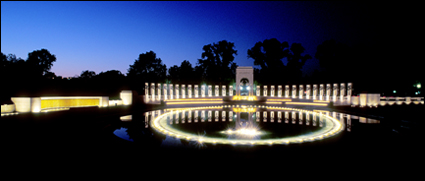
"Memorial at Night" by Richard Latoff / American Battle Monuments Commission
 Back to Top
Back to Top









